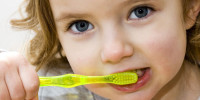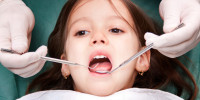Caring for a child’s health is characteristic of all loving parents. Requires attention everything that happens with the baby, a preschooler, a teenager. We remind all moms and dads that the full development of the whole organism is impossible without the proper development time (“milk”) and permanent teeth. The our clinic Smile Line observed children from zero and up and each age category of young patients is careful attention and professional assistance.
How to properly take care of the dental health of the child ?
Watch as smiling baby – it’s so nice! But even nicer to know that the baby teeth are not only beautiful, but also healthy.Teeth can get sick at any age, disease of adults and children are almost identical, but there are also features in their development. Since primary teeth enamel is softer, and then decay in children’s teeth develop much faster. In addition, in many cases, it takes absolutely painless, so no complaints in a child is not an indicator of dental health. It is important to regularly visit the dentist, since the advent of the very first teeth. After all, only an experienced specialist can diagnose the onset of the disease and do everything to prevent its further development.
What can I do for the health of her baby teeth?
First, you must own example to show the child that look after their teeth naturally to humans. Brush your teeth together, to each other, turn the process into a merry daily ritual. It is important not to miss a single cleaning, for any reason. The child must see that you never miss a procedure! Even if you are tired, do not say “nothing will clean more thoroughly tomorrow, and go to sleep now.”
Let the kid watches his toothbrush when it is time to change. Buy with toothpastes that he himself chose, what flavor it choose. When child gets older, you can teach him how to use an toothbrush . If the child becomes so habitual that, even as a teenager he would be able to take care of their teeth, thereby reducing the risk of caries. Professional dental procedure offers ultrasonic cleaning of the oral cavity . On the need for this procedure, you can consult with a our doctor, observing the child.
Why treat baby teeth?
Compliance with all the rules of oral hygiene does not guarantee that a person will never have tooth decay or gum disease. Poor water quality, unbalanced diet, genetic predisposition, stress – all this increases the risk of kariesa.K Unfortunately, even in today’s world, many parents believe that once the tooth is unstable, then treat it optional.Especially if the teeth have already begun to change, and “they do not have long.”
Let’s look at some reasons for the presence of the patient’s tooth in the mouth is not acceptable:
1. Availability rudiments of permanent teeth . Molars do not grow “out of nowhere.” Under the baby teeth are already the beginnings of permanent teeth. In the presence of caries acid produced by pathogenic organisms may damage them.
2. Pain . Even baby teeth may start to hurt badly, then treat the baby will be much harder.
3. Immunosuppression . Caries – a hotbed of infection, which reduces the overall immune system and can lead to chronic diseases of the oral cavity and pharynx.
4. Changing bite . If a child loses because of tooth decay tooth sooner than they should, the remaining teeth will move to close the “hole”, thus can shift the rudiments of the molars and prevent them from developing normally.
5. Halitosis . Yes, tooth decay causes bad breath, because of which the child may have problems with friends and peers.
As you can see, because of the baby tooth decay, the child may be a lot of nasty problems.
Dear Parents, protect your children’s health in the prevention and treatment of teeth in a timely manner, and your children will thank you with beautiful white smile!


